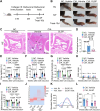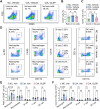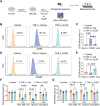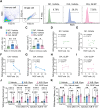Ganoderma lucidum spore powder alleviates rheumatoid arthritis-associated pain hypersensitivity through inhibiting accumulation, N1 polarization, and ROS production of neutrophils in mice
- PMID: 40370462
- PMCID: PMC12075414
- DOI: 10.3389/fimmu.2025.1569295
Ganoderma lucidum spore powder alleviates rheumatoid arthritis-associated pain hypersensitivity through inhibiting accumulation, N1 polarization, and ROS production of neutrophils in mice
Abstract
Introduction: Rheumatoid arthritis (RA) is a chronic condition characterized by joint pain that significantly impairs patients' work and daily lives. The limited understanding of the pathological mechanisms underlying RA-related pain poses challenges for effective clinical pain management. Ganoderma lucidum spore powder (GLSP) has demonstrated therapeutic benefits in various diseases, with no reported toxicity or adverse effects.
Methods: This study investigates the role of neutrophils in the pathological mechanisms of RA-related pain using collagen-induced arthritis (CIA) mice and an ex vivo neutrophil model. A combination of techniques, including animal models, flow cytometry, behavioral testing, cell adoptive transfer, and network pharmacology analysis, was employed to evaluate the effects and targets of GLSP on pain symptoms and neutrophil activity in CIA mice.
Results: Flow cytometric analysis revealed the accumulation and activation of neutrophils in the paws of CIA mice. Furthermore, the levels of pro-inflammatory CD95+ neutrophil subpopulations (N1 state) and ROS+ cells in the affected paws were positively correlated with the severity of mechanical allodynia and heat hyperalgesia observed in these mice. Our findings indicate that oral administration of GLSP significantly alleviates joint destruction, paw swelling, and pain hypersensitivity in CIA mice. Notably, GLSP reversed CIA-induced neutrophil accumulation, N1 polarization, and reactive oxygen species (ROS) production. Both network pharmacology target prediction and in vivo/in vitro experimental validation indicated that GLSP inhibits N1 polarization and ROS production in neutrophils by modulating the TNF-α signaling pathway, thus exerting RA-specific analgesic effects.
Discussion: In summary, this study offers new insights into the pathological mechanisms of RA-related pain and demonstrates that neutrophil accumulation, N1 polarization, and ROS production contribute to RA-related pain. GLSP alleviates RA-related pain by inhibiting the pro-inflammatory phenotype of neutrophils, highlighting its potential for clinical translation in the treatment of RA.
Keywords: Ganoderma lucidum spore powder; neutrophils; pain; reactive oxygen species; rheumatoid arthritis.
Copyright © 2025 Huang, Zhan, Xu, Liu, Fang, Wu, Liang, Liu, Wang, da Silva, Luo and Mo.
Conflict of interest statement
The authors declare that the research was conducted in the absence of any commercial or financial relationships that could be construed as a potential conflict of interest.
Figures









Similar articles
-
Geranyl hydroquinone alleviates rheumatoid arthritis-associated pain by suppressing neutrophil accumulation, N1 polarization and ROS production in mice.Redox Biol. 2025 May;82:103603. doi: 10.1016/j.redox.2025.103603. Epub 2025 Mar 18. Redox Biol. 2025. PMID: 40147153 Free PMC article.
-
Inhibitory effects of Ganoderma lucidum spore oil on rheumatoid arthritis in a collagen-induced arthritis mouse model.Biomed Pharmacother. 2023 Jan;157:114067. doi: 10.1016/j.biopha.2022.114067. Epub 2022 Dec 5. Biomed Pharmacother. 2023. PMID: 36481405
-
Protective effects of Catalpol to attenuate TNF- α and collagen-induced inflammation in vitro HFLS-RA cells and in vivo mice models for the treatment of rheumatoid arthritis.Clin Rheumatol. 2025 Mar;44(3):1041-1056. doi: 10.1007/s10067-024-07261-3. Epub 2025 Feb 5. Clin Rheumatol. 2025. PMID: 39907970
-
Protective Effect of Ganoderma lucidum Spore Powder on Acute Liver Injury in Mice and its Regulation of Gut Microbiota.Front Biosci (Landmark Ed). 2023 Feb 2;28(2):23. doi: 10.31083/j.fbl2802023. Front Biosci (Landmark Ed). 2023. PMID: 36866546
-
The role of neutrophils in pain: systematic review and meta-analysis of animal studies.Pain. 2025 Jun 1;166(6):1230-1249. doi: 10.1097/j.pain.0000000000003450. Epub 2024 Oct 25. Pain. 2025. PMID: 39450928
References
-
- Galloway J, Capron JP, De Leonardis F, Fakhouri W, Rose A, Kouris I, et al. . The impact of disease severity and duration on cost, early retirement and ability to work in rheumatoid arthritis in Europe: an economic modelling study. Rheumatol Adv Pract. (2020) 4:rkaa041. doi: 10.1093/rap/rkaa041 - DOI - PMC - PubMed
MeSH terms
Substances
LinkOut - more resources
Full Text Sources
Medical
Research Materials

